You may remember the story of the first Thanksgiving from your elementary school days, when you listened to the tale of the Pilgrims while you turned construction-paper cutouts of your hands into turkeys. But how much of that story is actually true? And how did Thanksgiving come to be an annual, national holiday? Feast with us on all of the information we dug up in HeinOnline regarding the history and controversy of Thanksgiving.
The Origin Story
What is generally considered the “first Thanksgiving” occurred after English settlers landed in Massachusetts Bay in 1620. Arriving upon the Mayflower, only half of the original Pilgrims, as these religious separatists who dissented from the Church of England came to be called, survived that harsh winter due to contagious disease and exposure to cold and moisture. The following March, Samoset,[1]Frank Stevenson, Happy Thanksgivings, 79 TEX. B.J. 748 (2016). This article can be found in HeinOnline’s Bar Journals Library. a member of the Abenaki tribe who spoke English, came to visit the settlers and brought along Squanto, a member of the Pawtuxet tribe, who proceeded to teach the Pilgrims how to grow corn, drain sap, catch fish, and avoid toxic plants,[2]Julia L. Ernst, The Mayflower Compact: Celebrating Four Hundred Years of Influence on U.S. Democracy, 95 N.D. L. REV. 1 (2020). This article can be found in HeinOnline’s Law Journal Library. while also helping them form a relationship with the local Indigenous tribe, the Wampanoag.
After a highly successful corn harvest in November 1621, with the Pilgrims’ prospects looking up, Governor William Bradford organized a feast, which some Indigenous peoples attended, including the Wampanoag chief Massasoit.
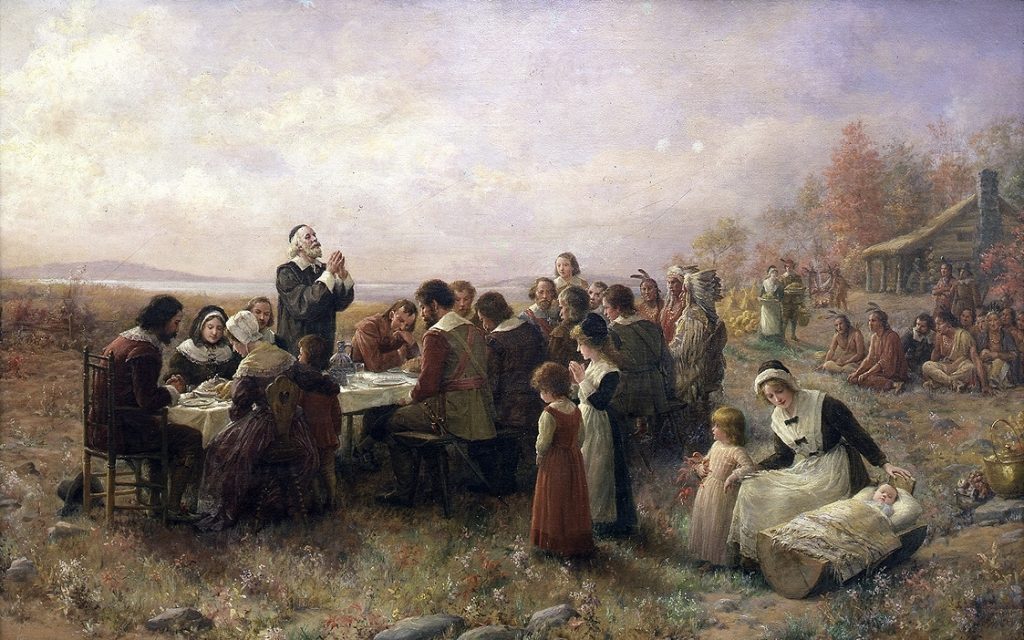
However, it is widely recognized that this was not technically the first “thanksgiving,” as days of thanks were often held even in ancient Egypt, Greece, and Rome, while Indigenous peoples would also frequently celebrate the fall harvest with a feast, long before the Europeans ever came to North American shores. Additionally, some argue that the actual first Thanksgiving occurred when settlers arrived at Berkeley Hundred in Virginia in 1619 and held a religious day of thanksgiving. There is an annual festival in Virginia to commemorate “America’s First Thanksgiving.”
A Haphazard Holiday
During the 18th and 19th centuries, thanksgivings were celebrated inconsistently and informally. In October of 1782, towards the end of the Revolutionary War, Congress announced November 28 of that year to be a day of thanksgiving.[3]Journals of the Continental Congress (1782). This document can be found in HeinOnline’s U.S. Congressional Documents database.
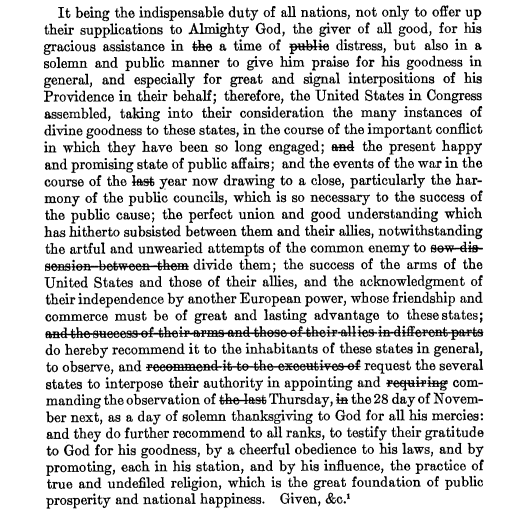
In 1789, George Washington proceeded to give the first presidential thanksgiving proclamation,[4]Edmund Alton. Among the Law-Makers (1886). This document can be found in HeinOnline’s Legal Classics library. in celebration of the end of the war and the ratification of the U.S. Constitution.
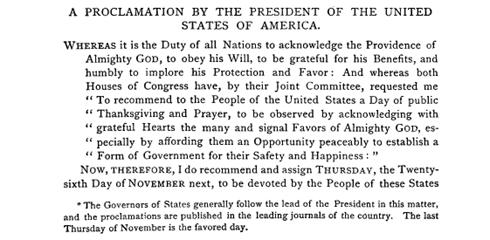
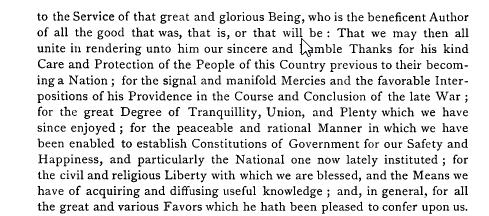
New York became the first state to adopt an official annual Thanksgiving holiday, with the state legislature officially sanctioning the celebration in 1830. Several states would soon follow—however, they did not all choose the same day.
Sarah Josepha Hale,[5]99 Our Dumb Animals 1 (1966). This article can be found in HeinOnline’s Law Journal Library. best known as the author of the nursery rhyme “Mary Had a Little Lamb,” began campaigning for a national Thanksgiving holiday in 1827. She wrote various editorials and sent letters to many politicians, and her plea was finally answered in 1863, when, during the Civil War, President Abraham Lincoln proclaimed an official Thanksgiving on the final Thursday of each November.[6]Henry J. Raymond. History of the Administration of President Lincoln: Including His Speeches, Letters, Addresses, Proclamations, and Messages (1864). This document can be found in HeinOnline’s U.S. Presidential Library.
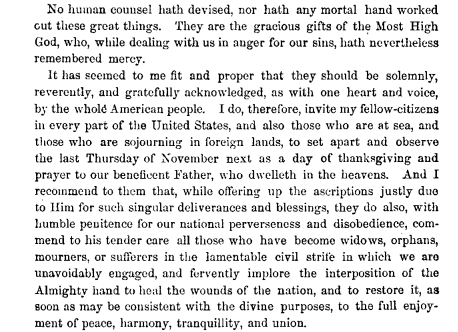
However, in 1939, with the nation slumped in the middle of the Great Depression, President Franklin Roosevelt decided to move Thanksgiving up a week in order to encourage retail sales. This decision was very unpopular and ignored by some states, to the point that FDR signed a bill in 1941 to officially designate the fourth Thursday of November as Thanksgiving.[7]“Making last Thursday in November legal holiday.” U.S. Congressional Serial Set, , 1941, pp. 1-2. HeinOnline, https://heinonline.org/HOL/P?h=hein.usccsset/usconset23111&i=303. This document can be found in … Continue reading
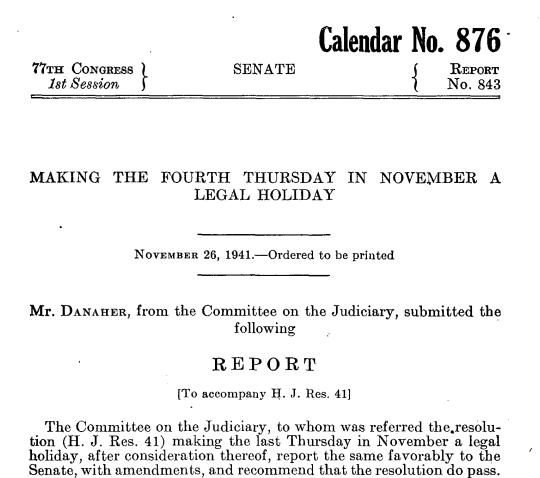
The Thanksgiving of Today
Today, Thanksgiving is the day that Americans feast upon turkeys, mashed potatoes, stuffing, and pumpkin pie—although it is highly likely that these were not the foods eaten at the first Thanksgiving. However, it is not a day of celebration for everyone. In many Indigenous cultures, Thanksgiving is called a “National Day of Mourning,”[8]David A. Furlow, Giving Thanks, 400 Years Later: Pilgrim Legacies That Shaped Texas, 10 TSCHS J. 72 (2021). This article can be found in HeinOnline’s Law Journal Library. a day of protest and remembrance of the deaths of millions of native peoples at the hands of white settlers, the stealing of their land, and the decimation of their culture. The story of the Pilgrims and the Indigenous peoples that shared the first Thanksgiving is considered myth to many, who argue that it is misleading in light of the bloody and brutal relationship between settlers and America’s Indigenous peoples throughout most of the country’s history. You can learn more about this history in our Indigenous Peoples of the Americas: History, Culture & Law database, which contains more than 2.3 million pages dedicated to Indigenous American life and law.
HeinOnline Sources[+]
| ↑1 | Frank Stevenson, Happy Thanksgivings, 79 TEX. B.J. 748 (2016). This article can be found in HeinOnline’s Bar Journals Library. |
|---|---|
| ↑2 | Julia L. Ernst, The Mayflower Compact: Celebrating Four Hundred Years of Influence on U.S. Democracy, 95 N.D. L. REV. 1 (2020). This article can be found in HeinOnline’s Law Journal Library. |
| ↑3 | Journals of the Continental Congress (1782). This document can be found in HeinOnline’s U.S. Congressional Documents database. |
| ↑4 | Edmund Alton. Among the Law-Makers (1886). This document can be found in HeinOnline’s Legal Classics library. |
| ↑5 | 99 Our Dumb Animals 1 (1966). This article can be found in HeinOnline’s Law Journal Library. |
| ↑6 | Henry J. Raymond. History of the Administration of President Lincoln: Including His Speeches, Letters, Addresses, Proclamations, and Messages (1864). This document can be found in HeinOnline’s U.S. Presidential Library. |
| ↑7 | “Making last Thursday in November legal holiday.” U.S. Congressional Serial Set, , 1941, pp. 1-2. HeinOnline, https://heinonline.org/HOL/P?h=hein.usccsset/usconset23111&i=303. This document can be found in HeinOnline’s U.S. Congressional Serial Set. |
| ↑8 | David A. Furlow, Giving Thanks, 400 Years Later: Pilgrim Legacies That Shaped Texas, 10 TSCHS J. 72 (2021). This article can be found in HeinOnline’s Law Journal Library. |



